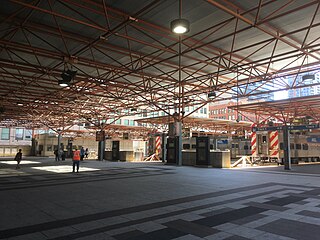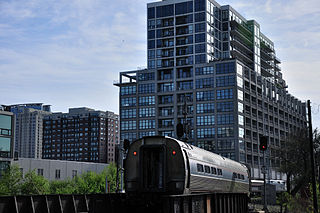
DeKalb is a city in DeKalb County, Illinois, United States. The population was 40,290 at the 2020 census. The city is named after decorated Franconian-French war hero Johann de Kalb, who died during the American Revolutionary War.

The Galena and Chicago Union Railroad (G&CU) was the first railroad constructed out of Chicago, intended to provide a shipping route between Chicago and the lead mines near Galena, Illinois. The railroad company was chartered on January 16, 1836, but financial difficulties delayed construction until 1848. While the main line never reached Galena, construction to Freeport, Illinois, allowed it to connect with the Illinois Central Railroad, thus providing an indirect route to Galena. A later route went to Clinton, Iowa.

Metra is the primary commuter rail system in the Chicago metropolitan area serving the city of Chicago and its surrounding suburbs via the Union Pacific Railroad, BNSF Railway, and other railroads. The system operates 243 stations on 11 rail lines. It is the fourth busiest commuter rail system in the United States by ridership and the largest and busiest commuter rail system outside the New York City metropolitan area. In 2023, the system had a ridership of 31,894,900, or about 147,800 per weekday as of the first quarter of 2024. The estimated busiest day for Metra ridership occurred on November 4, 2016—the day of the Chicago Cubs 2016 World Series victory rally.

The Chicago and North Western was a Class I railroad in the Midwestern United States. It was also known as the "North Western". The railroad operated more than 5,000 miles (8,000 km) of track at the turn of the 20th century, and over 12,000 miles (19,000 km) of track in seven states before retrenchment in the late 1970s. Until 1972, when the employees purchased the company, it was named the Chicago and North Western Railway.

The Illinois Central Railroad, sometimes called the Main Line of Mid-America, was a railroad in the Central United States. Its primary routes connected Chicago, Illinois, with New Orleans, Louisiana, and Mobile, Alabama, and thus, the Great Lakes to the Gulf of Mexico. Another line connected Chicago west to Sioux City, Iowa (1870), while smaller branches reached Omaha, Nebraska (1899) from Fort Dodge, Iowa, and Sioux Falls, South Dakota (1877), from Cherokee, Iowa. The IC also ran service to Miami, Florida, on trackage owned by other railroads.

The Richard B. Ogilvie Transportation Center, on the site of the former Chicago and North Western Terminal, is a commuter rail terminal in downtown Chicago, Illinois. For the last century, this site has served as the primary terminal for the Chicago and North Western Railway and its successors Union Pacific and Metra. Intercity services had disappeared by the 1970s, but commuter services on the three ex-CNW mainlines, Metra's UP District lines, continue to terminate here. The tracks are elevated above street level. The old CNW terminal building was replaced in the mid 1980s with a modern skyscraper, the 500 West Madison Street building. The modern building occupies two square city blocks, bounded by Randolph Street and Madison Street to the north and south and by Canal Street and Clinton Street to the east and west. It is the second busiest rail station in Chicago, after nearby Union Station, the sixth-busiest railway station in North America, and the third-busiest station that exclusively serves commuter traffic.

The Union Pacific North Line (UP-N) is a Metra line in the Chicago metropolitan area. It runs between Ogilvie Transportation Center and Kenosha, Wisconsin; however, most trains terminate in Waukegan, Illinois. Although Metra owns the rolling stock, the trains are operated and dispatched by the Union Pacific Railroad. This line was previously operated by the Chicago & North Western Railway before its merger with the Union Pacific Railroad, and was called the Chicago and North Western Milwaukee Division and then the Chicago & North Western/North Line before the C&NW was absorbed by Union Pacific in April 1995. It is the only Metra line that travels outside Illinois.

The Union Pacific West Line (UP-W) is a Metra commuter rail line operated by Union Pacific Railroad in Chicago, Illinois and its western suburbs. Metra does not refer to its lines by particular colors, but the timetable accents for the Union Pacific West line are "Kate Shelley Rose" pink, honoring an Iowa woman who saved a Chicago & North Western Railway train from disaster in 1881. Green and yellow were already selected for the Union Pacific North Line and Union Pacific Northwest Line, respectively, so pink was chosen for this line. Therefore, the UP-W is the only Metra line that uses a color to honor a person instead of a fallen flag railroad. Until the late 1940s the line had a branch to Freeport, Illinois. It diverged from the main line at West Chicago and had stations at Elgin, Marengo, Belvidere, Rockford, Freeport, and other communities. The line was once known as the Chicago & Northwestern/West Line until UP took over the C&NW in 1995. All Metra trains on this line terminated at Geneva until 2006, when the line was extended to its present terminus in Elburn. The line runs as part of the Union Pacific Railroad's Geneva Subdivision.

The Union Pacific Northwest Line (UP-NW) is a commuter rail line provided by Metra and operated by the Union Pacific Railroad in Chicago, Illinois and its surrounding suburbs. While Metra does not refer to any of its lines by colors, the timetable accents for the Union Pacific Northwest Line are bright "Viking Yellow," honoring the Chicago & North Western Railway's Viking passenger train.

The Milwaukee District West Line (MD-W) is a Metra commuter rail line in Chicago, Illinois, and its western suburbs. Metra does not refer to any of its lines by a particular color, but the timetable accents for the Milwaukee District West line are dark "Arrow Yellow," honoring the Milwaukee Road's Arrow passenger train. Trains are dispatched from the Canadian Pacific Kansas City Railway's American headquarters in Minneapolis.

LaSalle Street Station is a commuter rail terminal at 414 South LaSalle Street in downtown Chicago. First used as a rail terminal in 1852, it was a major intercity rail terminal for the New York Central Railroad until 1968, and for the Chicago, Rock Island and Pacific Railroad until 1978, but now serves only Metra's Rock Island District. The present structure became the fifth station on the site when its predecessor was demolished in 1981 and replaced by the new station and the One Financial Place tower for the Chicago Stock Exchange. The Chicago Board of Trade Building, Willis Tower, and Harold Washington Library are nearby.

The St. Charles Air Line is a rail line in Chicago, Illinois, partially owned by the BNSF Railway, Union Pacific Railroad (UP), and Canadian National Railway (CN).

Evanston Davis Street is a commuter railroad station in downtown Evanston, Illinois. It is served by Metra's Union Pacific North Line with trains going south to Ogilvie Transportation Center in Chicago and as far north as Kenosha, Wisconsin. In Metra's zone-based fare system, Davis Street is in zone 2. As of 2018, Evanston Davis Street is the 12th busiest of Metra's 236 non-downtown stations, with an average of 1,876 weekday boardings. The station is next to the Davis station of the Chicago Transit Authority's Purple Line, where CTA and Pace buses terminate. Between the two stations is 909 Davis Street, a six-story building with a kiss-and-ride loop for car drop-off.

Elmhurst is a Metra commuter railroad station in downtown Elmhurst, Illinois, a western suburb of Chicago. It is served by the Union Pacific West Line, and lies 15.7 miles (25.3 km) from the eastern terminus. Trains go east to Ogilvie Transportation Center in Chicago and as far west as Elburn, Illinois. Travel time to Ogilvie ranges from 39 minutes on local trains to 26 minutes on express trains, as there are some trains that go non-stop between Elmhurst and Chicago. Evening peak trains make the run between Ogilvie and Elmhurst in as little as 24 minutes. As of 2018, Elmhurst is the fourth busiest of the 236 non-downtown stations in the Metra system, with an average of 2,540 weekday boardings. Unless otherwise announced, inbound trains use the north platform and outbound trains use the south platform.

Elburn is a station on Metra's Union Pacific West Line located in Elburn, Illinois. The station is the western terminus of the West Line. The station is 43.8 miles (70.5 km) away from Ogilvie Transportation Center along the railroad tracks. Elburn station opened on January 23, 2006, when the West Line was extended from Geneva. The station is located at ground level. A large coach yard is located just east of the station. As of 2018, Elburn is the 137th busiest of the 236 non-downtown stations in the Metra system, with an average of 336 weekday boardings.

Geneva is a Metra commuter railroad station in Geneva, Illinois, served by Metra's Union Pacific West Line. The station is 35.5 miles (57.1 km) away from Ogilvie Transportation Center. In Metra's zone-based fare structure, Geneva is in zone 4. As of 2018, Geneva is the 14th busiest of the 236 non-downtown stations in the Metra system, with an average of 1,742 weekday boardings. Unless otherwise announced, inbound trains use the north platform and outbound trains use the south platform.

La Fox is the penultimate station on Metra's Union Pacific West Line, located in La Fox, Illinois, an unincorporated area in Kane County, Illinois. The station is 41.1 miles (66.1 km) away from Ogilvie Transportation Center, the eastern terminus of the West Line. In Metra's zone-based fare system, La Fox is in zone 4. As of 2018, La Fox is the 146th busiest of the 236 non-downtown stations in the Metra system, with an average of 295 weekday boardings. Unless otherwise announced, inbound trains use the north (island) platform and outbound trains use the south (side) platform. The northernmost track, despite being adjacent to the island platform, is used exclusively by freight trains.
Car 553 is a privately owned railroad passenger car. It operated exclusively on Metra's Union Pacific North Line in Northeastern Illinois, and was the last privately-owned membership-based commuter rail car operating in the United States.

Dempster Street was a commuter railroad station on the Chicago and North Western Railway's Milwaukee Division, now the Union Pacific North Line. The station was located at Dempster Street and Sherman Avenue, in Evanston, Illinois. It was adjacent the CTA Purple Line's Dempster station.


















